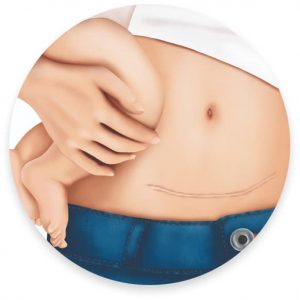The right steps after a caesarean section
How can you take care of your scar? How should you look after your child? How do you recover from the operation?… Many mothers have many questions following a caesarean section. Here are the steps to take in this particular time.
How to take care of your scar
During a caesarean section, a small incision is made in the mother’s tummy to extract the baby. Once the operation is complete, you will have a scar. Here are some best practices for taking care of it!
Clean your scar
Make sure to clean the wound daily. For this, use a neutral soap and clear water. Allow it to air dry, then dab with a towel.
In the days after the caesarean section, if you have difficulty getting up, you can take a shower using a small stool so as not to tire yourself further.
Massage your scar
The benefits of massaging are numerous! For instance, it can help to blur marks and reduce the risk of inflammation and other skin lesions. Wash and dry your hands thoroughly, then gently massage the area with a suitable product, as advised by a healthcare professional.
Home massage tutorial:
- Lie comfortably on your back using a cushion for support, and bend your knees.
- Gently apply the product on the scar by making small circles with your middle three fingers.
- With the same fingers, make small movements up and down and side to side.
It should be noted that, during the first few days, your scar will be too sensitive and you will not be able to massage it immediately.
Protect your scar
You are advised to not expose your scar to the sun during the first six months, as there is a risk of further pigmentation. Always remember to apply sunscreen.TIP: Preferred clothing
As your scar is still particularly sensitive in the days following your caesarean section, you are advised to avoid trousers and skirts with a fastening. As regards underwear, low- or high-waisted knickers are preferential. Taking these precautions will help to avoid unpleasant friction on the wound.How to breastfeed your child
Good news! Breastfeeding after a caesarean section is possible! Breast milk has multiple benefits: it strengthens your child’s immune defences while helping to promote its well-being. Discover the post-caesarean breastfeeding positions that won’t cause you discomfort.

Breastfeeding in a lying-down position
Lie comfortably on your side and place your baby level with your chest. Remember to support his/her back. You can use cushions for support.
Breastfeeding while sitting
When your scar is less sensitive, you can breastfeed in a sitting position with cushions. Place your baby against you and rest his/her head on your forearm and support his/her back.
How to take care of yourself
A caesarean section remains a surgical act, which is tiring for the mother. Therefore, it is important to take it easy.
Get help
After your operation, surround yourself with family and friends who can help you. This support will allow you to take breaks during the day.
Start moving again
While it is important to rest, it is not recommended that you remain immobile. If you can, get up as soon as possible after your operation, but get help to do so.
Starting to move again will help you avoid phlebitis and embolism.
It should be noted that if you feel able to, you can carry your baby, taking care not to press on your wound. If not, let someone carry him/her for you in the first stages.

Skin-to-skin contact for extra relief1…
Skin-to-skin contact is a privileged moment to be shared with your child as much as possible! It can help to achieve a stronger bond, make breastfeeding easier, and have a calming effect for both of you. In addition, it has been proven to reduce the pain experienced following the operation!
The post-caesarean period can sometimes be somewhat disconcerting for the mother. Take the time to settle into things and, above all, trust yourself; only you know what is best for your baby.
BA20-246
- Moore E., et al., Early skin-to-skin contact for mothers and their healthy newborn infants, Cochrane Database Syst Rev. Author manuscript; available in PMC 2014 April 08.
Further Reading

How to prepare for a cesarean?
In what cases is a cesarean section scheduled? How is the operation going? Why is it important to surround yourself well?
Read More

Having a Caesarean Section
Some women may know they need a caesarean (C-section) long before they give birth, but for others, the decision might not be made until they go into labour.
Read More



